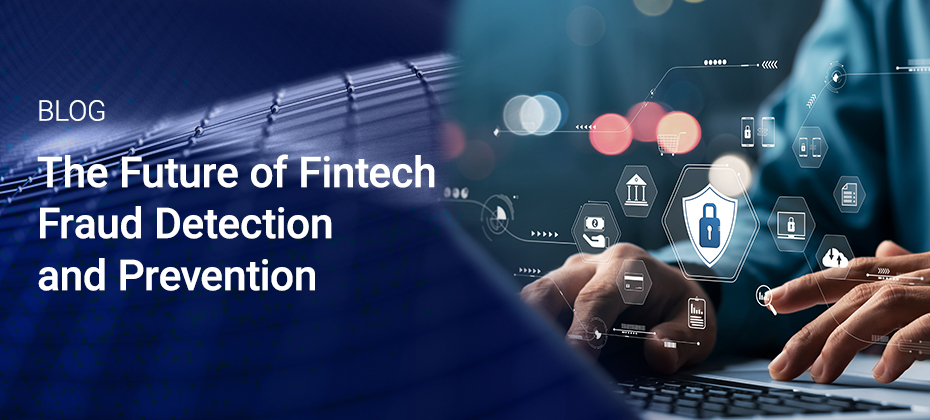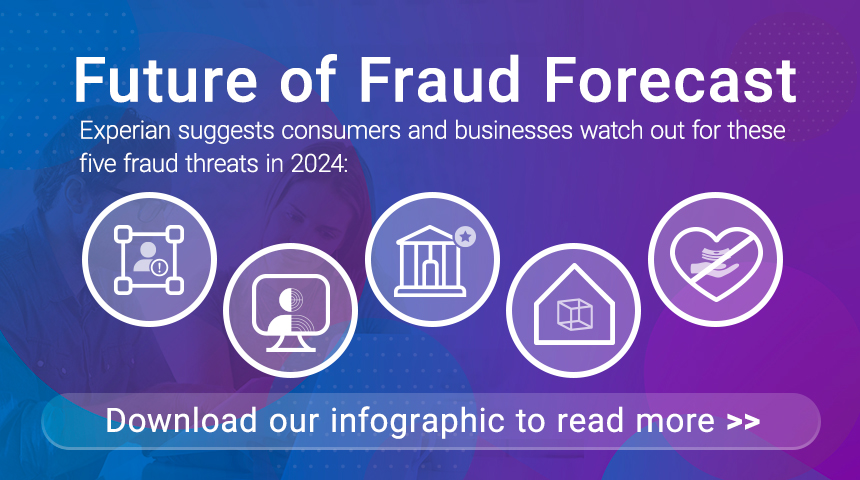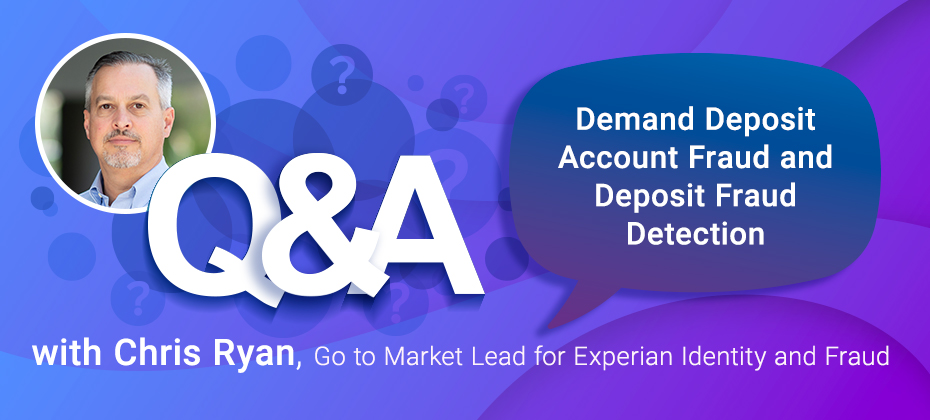Search Results for: synthetic id

In this article...Understanding the scope of fintech fraudThe importance of fintech fraud preventionSynthetic identity (ID) fraud: A growing threatHow fintech fraud detection and prevention are evolvingGet started today The integration of technology with traditional financial services has unlocked unprecedented convenience and opportunities for consumers and businesses alike. However, this digital shift has opened the door for more sophisticated fraud tactics. With fraudsters continuously refining their methods, fintech companies must invest in advanced fintech fraud detection and prevention solutions. Understanding the scope of fintech fraud As fintech platforms expand, they also attract the attention of cybercriminals. The accessibility of digital financial services can create vulnerabilities that fraudsters exploit, executing everything from personal account takeovers to larger-scale breaches involving synthetic identities. Source: Experian’s U.S. Identity & Fraud Report To counter these threats, fintech companies must deploy innovative fraud management solutions powered by artificial intelligence (AI), machine learning (ML), and advanced analytics. Unlike traditional methods that often rely on static rules and manual reviews, these solutions can process vast amounts of data, learn from historical patterns, and detect anomalies in real-time. This allows organizations to identify suspicious activities before they lead to significant losses. The importance of fintech fraud prevention While detecting fraud is crucial, preventing it from occurring in the first place is even more important. Fraud prevention solutions aim to create robust systems that stop fraudsters in their tracks before they can cause damage. With the rise of digital financial services, the need for proactive fraud prevention measures has never been greater. These solutions protect both consumers and businesses from financial harm, reducing the risk of financial loss and reputational damage. Advanced fraud prevention solutions employ multilayered strategies, combining AI-driven fraud detection tools with methods such as multifactor authentication and biometric identity verification. These tools create an extra layer of security, making it difficult for fraudsters to access sensitive data or execute fraudulent transactions. Experian’s fraud prevention solutions offer businesses a comprehensive suite of tools designed to prevent various types of fraud. From real-time transaction monitoring to sophisticated user authentication methods, these solutions provide the protection businesses need to stay ahead of evolving fraud tactics. Synthetic identity (ID) fraud: A growing threat One of the most concerning forms of fraud that fintech companies face is synthetic ID fraud. This type of fraud involves the creation of a fake identity using a combination of real and fabricated information. Fraudsters often steal pieces of personal data — such as Social Security numbers or addresses—and then combine them with fictional information to create a new, synthetic identity. These synthetic identities can be used to open bank accounts, apply for credit cards, or take out loans, leaving businesses and consumers vulnerable to significant financial losses. Synthetic ID fraud is particularly difficult to detect because the synthetic identity often looks legitimate to traditional verification systems. As a result, fintech companies must deploy sophisticated fraud detection systems that can identify synthetic identities before they’re used to commit fraud. Machine learning algorithms, for instance, can analyze behavioral data, detecting discrepancies that may indicate a synthetic identity. Experian is ranked #1 by the Center for Financial Professionals (CeFPro®) for Identity and Fraud. The ranking appeared in CeFPro’s Fintech Leaders Report, a comprehensive annual study of the fintech industry. How fintech fraud detection and prevention are evolving As fraudsters continue to evolve their tactics, fintech companies must remain one step ahead by investing in cutting-edge fraud detection and prevention technologies. Real-time monitoring, predictive analytics, and biometrics are just a few of the technologies shaping the future of fraud detection. By integrating these technologies into their fraud management processes, fintech companies can offer a more secure and seamless experience for their users. With the acquisition of NeuroID, an industry leader in behavioral analytics, Experian has amplified its fraud risk suite by providing a new layer of insight into digital behavioral signals and analytics. Available through our fraud solutions on the Experian Ascend PlatformTM, clients can proactively monitor and analyze a user’s real-time digital behavior, allowing them to confidently navigate the online landscape and provide frictionless customer experiences. Get started today As the fraud landscape continues to evolve, fintech companies must adopt comprehensive solutions to stay ahead of emerging threats. By doing so, they can protect themselves and their customers, ensuring the continued success of digital financial services in the years to come. To learn more, check out our fraud management and fintech solutions. Fraud management solutions Fintech solutions

In this article...Rise of AI in fraudulent activitiesFighting AI with AI Addressing fraud threatsBenefits of leveraging AI fraud detectionFinancial services use caseExperian's AI fraud detection solutions In a world where technology evolves at lightning speed, fraudsters are becoming more sophisticated in their methods, leveraging advancements in artificial intelligence (AI). According to our 2025 U.S. Identity and Fraud Report, 72% of businesses expect AI fraud to be among their top challenges by 2026. To combat emerging fraud threats, organizations are turning to AI fraud detection to stay ahead and protect their businesses and their customers, essentially fighting AI with AI. This blog post explores the evolving AI fraud and AI fraud detection landscape. The rise of AI in fraudulent activities Technology is a double-edged sword. While it brings numerous advancements, it also provides fraudsters with new tools to exploit. AI is no exception. Here are some ways fraudsters are utilizing AI: Automated bot attacks: Fraudsters employ AI to design automated scripts that launch large-scale attacks on systems. These scripts can perform credential stuffing, where stolen usernames and passwords are automatically tested across multiple sites to gain unauthorized access. Deepfakes and synthetic identities: Deepfake technology and the creation of synthetic identities are becoming more prevalent. Fraudsters use AI to manipulate videos and audio, making it possible to impersonate individuals convincingly. Similarly, synthetic identities blend real and fake information to create false personas. Phishing and social engineering: AI-driven phishing attacks are more personalized and convincing than traditional methods. By analyzing social media profiles and other online data, fraudsters craft tailored messages that trick individuals into revealing sensitive information. Watch now: Our 2025 Fraud Trends webinar explores how businesses can navigate rising risk, meet growing consumer expectations, and stay ahead of increasingly complex attacks. Fighting AI with AI in fraud detection To combat these sophisticated threats, businesses must adopt equally advanced measures. AI fraud detection offers a robust solution: Machine learning algorithms: Fraud detection machine learning algorithms analyze vast datasets to identify patterns and anomalies that indicate fraudulent behavior. These algorithms can continuously learn and adapt, improving their accuracy over time. Real-time monitoring: AI systems provide real-time monitoring of transactions and activities. This allows businesses to detect and respond to fraud attempts instantly, minimizing potential damage. Predictive analytics: Predictive analytics uses historical data to forecast future fraud trends. By anticipating potential threats, organizations can take proactive measures to safeguard their assets. Addressing fraud threats with AI fraud detection AI's versatility allows it to tackle various types of fraud effectively: Identity theft: According to our research, 68% of consumers rank identity theft as their top online concern. AI systems can help safeguard consumers by cross-referencing multiple data points to verify identities. They can spot inconsistencies that indicate identity theft, such as mismatched addresses or unusual login locations. Payment fraud: Coming in second to identity theft, 61% of consumers rank stolen credit card information as their top online concern. Payment fraud includes unauthorized credit card transactions and chargebacks. AI can be used in payment fraud detection to surface unusual spending patterns and flag suspicious transactions for further investigation. Account takeover: Account takeover fraud, one of the top-most encountered fraud events reported by U.S. businesses, occurs when fraudsters gain access to user accounts and conduct unauthorized activities.* AI identifies unusual login behaviors and implements additional security measures to prevent account breaches. Synthetic identity fraud: Synthetic identity fraud involves the creation of fake identities using real and fabricated information. AI fraud solutions detect these false identities by analyzing data inconsistencies and behavioral patterns. Benefits of leveraging AI fraud detection Implementing AI fraud detection offers numerous advantages: Enhanced accuracy: AI systems are highly accurate in identifying fraudulent activities. Their ability to analyze large datasets and detect subtle anomalies surpasses traditional methods. Cost savings: By preventing fraud losses, AI systems save businesses significant amounts of money. They also reduce the need for manual investigations, freeing up resources for other tasks. Improved customer experience: AI fraud detection minimizes false positives, ensuring genuine customers face minimal friction. This enhances the overall customer experience and builds trust in the organization. Scalability: AI systems can handle large volumes of data, making them suitable for organizations of all sizes. Whether you're a small business or a large enterprise, AI can scale to meet your needs. Financial services use case The financial sector is particularly vulnerable to fraud, making AI an invaluable tool for fraud detection in banking. Protecting transactions: Banks use AI to monitor transactions for signs of fraud. Machine learning algorithms analyze transaction data in real time, flagging suspicious activities for further review. Enhancing security: AI enhances security by implementing multifactor authentication and behavioral analytics. These measures make it more challenging for fraudsters to gain unauthorized access. Reducing fraud losses: By detecting and preventing fraudulent activities, AI helps banks reduce their fraud losses throughout the customer lifecycle. This not only saves money but also protects the institution's reputation. Experian's AI fraud detection solutions AI fraud detection is revolutionizing the way organizations combat fraud. Its ability to analyze vast amounts of data, detect anomalies, and adapt to new threats makes it an essential element of any comprehensive fraud strategy. Experian’s range of AI fraud detection solutions help organizations enhance their security measures, reduce fraud losses, authenticate identity with confidence, and improve the overall customer experience. If you're interested in learning more about how AI can protect your business, explore our fraud management solutions or contact us today. Learn More * Source: 2025 U.S. Identity and Fraud Report This article includes content created by an AI language model and is intended to provide general information.

“Learn how to learn.” One of Zack Kass’, AI futurist and one of the keynote speakers at Vision 2024, takeaways readily embodies a sentiment most of us share — particularly here at Vision. Jennifer Schulz, CEO of Experian, North America, talked about AI and transformative technologies of past and present as she kicked off Vision 2024, the 40th Vision. Keynote speaker: Dr. Mohamed El-Erian Dr. Mohamed El-Erian, President of Queens’ College, Cambridge and Chief Economic Advisor at Allianz, returned to the Vision stage to discuss the labor market, “sticky” inflation and the health of consumers. He emphasized the need to embrace and learn how to talk to AI engines and that AI can facilitate content, creation, collaboration and community Keynote speaker: Zack Kass Zack Kass, AI futurist and former Head of Go-To-Market at OpenAI, spoke about the future of work and life and artificial general intelligence. He said AI is aiding in our entering of a superlinear trajectory and compared the thresholds of technology versus those of society. Sessions – Day 1 highlights The conference hall was buzzing with conversations, discussions and thought leadership. Some themes definitely rose to the top — the increasing proliferation of fraud and how to combat it without diminishing the customer experience, leveraging AI and transformative technology in decisioning and how Experian is pioneering the GenAI era in finance and technology. Transformative technologiesAI and emerging technologies are reshaping the finance sector and it's the responsibility of today's industry leaders to equip themselves with cutting-edge strategies and a comprehensive understanding to master the rapidly evolving landscape. That said, transformation is a journey and aligning with a partner that's agile and innovative is critical. Holistic fraud decisioningGenerative AI, a resurgence of bank branch transactions, synthetic identity and pig butchering are all fraud trends that today's organizations must be acutely aware of and armed to protect their businesses and customers against. Leveraging a holistic fraud decisioning strategy is important in finding the balance between customer experience and mitigating fraud. Unlocking cashflow to grow, protect and reduce riskCash flow data can be used not only across the lending lifecycle, but also as part of assessing existing portfolio opportunities. Incorporating consumer-permissioned data into models and processes powers predicatbility and can further assess risk and help score more consumers. Navigating the economyAmid a slowing economy, consumers and businesses continue to struggle with higher interest rates, tighter credit conditions and rising delinquencies, creating a challenging environment for lenders. Experian's experts outlined their latest economic forecasts and provided actionable insights into key consumer and commercial credit trends. More insights from Vision to come. Follow @ExperianVision and @ExperianInsights to see more of the action.

Financial institutions have long relied on anti-money laundering (AML) and anti-fraud systems to protect themselves and their customers. These departments and systems have historically operated in siloes, but that’s no longer best practice. Now, a new framework that integrates fraud and AML, or FRAML, is taking hold as financial institutions see the value of sharing resources to fight fraud and other financial crimes. You don’t need to keep them separated For fraudsters, fraud and money laundering go hand-in-hand. By definition, someone opening an account and laundering money is committing a crime. The laundered funds are also often from illegal activity — otherwise, they wouldn’t need to be laundered. For financial institutions, different departments have historically owned AML and anti-fraud programs. In part, because AML and fraud prevention have different goals: AML is about staying compliant: AML is often owned by an organization’s compliance department, which ensures the proper processes and reporting are in place to comply with relevant regulations. Fraud is about avoiding losses: The fraud department identifies and stops fraudulent activity to help protect the organization from reputational harm and fraud losses. As fraudsters’ operations become more complex, the traditional separation of the two departments may be doing more harm than good. Common areas of focus There has always been some overlap in AML and fraud prevention. After all, an AML program can stop criminals from opening or using accounts that could lead to fraud losses. And fraud departments might stop suspicious activity that’s a criminal placing or layering funds. While AML and fraud both involve ongoing account monitoring, let’s take a closer look at similarities during the account creation: Verifying identities: Financial institutions’ AML programs must include know your customer (KYC) procedures and a Customer Identification Program (CIP). Being able to verify the identity of a new customer can be important for tracing transactions back to an individual or entity later. Similarly, fraud departments want to be sure there aren’t any red flags when opening a new account, such as a connection between the person or entity and previous fraudulent activity. Preventing synthetic identity fraud: Criminals may try to use synthetic identities to avoid triggering AML or fraud checks. Synthetic identity fraud has been a growing problem, but the latest solutions and tools can help financial institutions stop synthetic identity fraud across the customer lifecycle. Detecting money mules: Some criminals recruit money mules rather than using their own identity or creating a synthetic identity. The mules are paid to use their legitimate bank account to accept and transfer funds on behalf of the criminal. In some cases, the mule is an unwitting victim of a scam and an accomplice in money laundering. Although the exact requirements, tools, processes, and reports for AML and fraud differ, there’s certainly one commonality — identify and stop bad actors. Interactive infographic: Building a multilayered fraud and identity strategy The win-win of the FRAML approach Aligning AML and fraud could lead to cost savings and benefits for the organization and its customers in many ways. Save on IT costs: Fraud and AML teams may benefit from similar types of advanced analytics for detecting suspicious activity. In 2023, around 60 percent of businesses were using or trying to use machine learning (ML) in their fraud strategies, but a quarter said cost was impeding implementation.1 If fraud and AML can share IT resources and assets, they might be able to better afford the latest ML and AI solutions. Avoid duplicate work: Cost savings can also happen if you can avoid having separate AML and fraud investigations into the same case. The diverse backgrounds and approaches to investigations may also lead to more efficient and successful outcomes. Get a holistic view of customers: Sharing information about customers and accounts also might help you more accurately assess risk and identify fraud groups. Improve your customer experience: Shared data can also reduce customer outreach for identity or transaction verifications. Creating a single view of each account or customer can also improve customer onboarding and account monitoring, leading to fewer false positives and a better customer experience. Some financial institutions have implemented collaboration with the creation of a new team, sometimes called the financial crimes unit (FCU). Others may keep the departments separate but develop systems for sharing data and resources. Watch the webinar: Fraud and identity challenges for Fintechs How Experian can help Creating new systems and changing company culture doesn’t happen overnight, but the shift toward collaboration may be one of the big trends in AML and fraud for 2024. As a leader in identity verification and fraud prevention, Experian can offer the tools and strategies that organizations need to update their AML and fraud processes across the entire customer lifecycle. CrossCore® is our integrated digital identity and fraud risk platform which enables organizations to connect, access, and orchestrate decisions that leverage multiple data sources and services. CrossCore cloud platform combines risk-based authentication, identity proofing and fraud detection, which enables organizations to streamline processes and quickly respond to an ever-changing environment. In its 2023 Fraud Reduction Intelligence Platforms (FRIP), Kuppinger Cole wrote, “Once again, Experian is a Leader in Fraud Reduction Intelligence Platforms. Any organizations looking for a full-featured FRIP service with global support should consider Experian CrossCore.” Learn more about Experian’s AML and fraud solutions. 1. Experian (2023). Experian's 2023 Identity and Fraud Report

Know Your Customer (KYC) procedures are a requirement for banks and other financial institutions to collect and verify the identity of their customers. When a bank verifies the identity of another organization or its owners, the process may be called Know Your Business (KYB) instead. As part of banks’ anti-money laundering (AML) programs, KYC can help stop corruption, money laundering and terrorist financing. Creating and maintaining KYC programs is also important for regulatory compliance, reputation management and fraud prevention. READ: How to Build a Know Your Customer Checklist – Everything You Need to Know The three components of KYC programs Banks can largely determine how to set up their KYC and AML programs within the applicable regulatory guidelines. In the United States, KYC needs to happen when banks initially onboard a new customer. But it’s not a one-and-done event—ongoing customer and transaction monitoring is also important. Customer Identification Program (CIP) Creating a robust Customer Identification Program (CIP) is an essential part of KYC. At a minimum, a bank’s CIP requires it to collect the following information from new customers: Name Date of birth Address Identification number, such as a Social Security number (SSN) or Employer Identification Number (EIN) Banks' CIPs also have to use risk-based procedures to verify customers’ identities and form a reasonable belief that they know the customer's true identity.1 This might involve comparing the information from the application to the customer’s government-issued ID, other identifying documents and authoritative data sources, such as credit bureau databases. Additionally, the bank's CIP will govern how the bank: Retains the customer’s identifying information Compares customer to government lists Provides customers with adequate notices Banks can create CIPs that meet all the requirements in various ways, and many use third-party solutions to quickly collect data, detect forged or falsified documents and verify the provided information. INFOGRAPHIC: Streamlining the Digital Onboarding Process: Beating Fraud at its Game Customer due diligence (CDD) CIP and CDD overlap, but the CIP primarily verifies a customer’s identity while customer due diligence (CDD) helps banks understand the risk that each customer poses. To do this, banks try to understand what various types of customers do, what those customers’ normal banking activity looks like, and in contrast, what could be unusual or suspicious activity. Financial institutions can use risk ratings and scores to evaluate customers and then use simplified, standard or enhanced due diligence (EDD) processes based on the results. For example, customers who might pose a greater risk of laundering money or financing terrorism may need to undergo additional screenings and clarify the source of their funds. Ongoing monitoring Ongoing or continuous monitoring of customers’ identities and transactions is also important for staying compliant with AML regulations and stopping fraud. The monitoring can help banks spot a significant change in the identity of the customer, beneficial owner or account, which may require a new KYC check. Unusual transactions can also be a sign of money laundering or fraud, and they may require the bank to file a suspicious activity report (SAR). Why is KYC important in banking? Understanding and implementing KYC processes can be important for several reasons: Regulatory compliance: Although the specific laws and rules can vary by country or region, many banks are required to have AML procedures, including KYC. The fines for violating AML regulations can be in the hundreds of millions— a few banks have been fined over $1 billion for lax AML enforcement and sanctions breaching. Reputation management: In some cases, enforcement actions and fines were headline news. Banks that don’t have robust KYC procedures in place risk losing their customers' trust and respect. Fraud prevention: In addition to the regulatory requirements, KYC policies and systems can also work alongside fraud management solutions for banks. Identity verification at onboarding can help banks identify synthetic identities attempting to open money mule accounts or take out loans. Ongoing monitoring can also be important for identifying long-term fraud schemes and large fraud rings. ON-DEMAND WEBINAR: Fraud Strategies for a Positive Customer Experience KYC in a digital-first world Many financial institutions have been going through digital transformations. Part of that journey is updating the systems and tools in place to meet the expectations of customers and regulators. An Experian survey found that about half of consumers (51 percent) consider abandoning the creation of a new account because of friction or a less-than-positive experience — that increased to 69 percent for high-income households.2 The survey wasn’t specific to financial services, but friction could be a problem for banks wanting to attract new account holders. Just as access to additional data sources and machine learning help automate underwriting, financial institutions can use technological advances to add an appropriate amount of friction based on various risk signals. Some of these can be run in the background, such as an electronic Consent Based Social Security Number Verification (eCBSV) check to verify the customer’s name, SSN and date of birth match the Social Security Administration’s records. Others may require more customer involvement, such as taking a selfie that’s then compared to the image on their photo ID — Experian CrossCore® Doc Capture enables this type of verification. Experian is a leader in identity and data management Experian's identity verification solutions use proprietary and third-party data to help banks manage their KYC procedures, including identity verification and Customer Identification Programs. By bundling identity verification with fraud assessment, banks can stop fraudsters while quickly resolving identity discrepancies. The automated processes also allow you to offer a low-friction identity verification experience and use step-up authentications as needed. Learn more about Experian’s identity solutions. 1FDIC (2021). Customer Identification Program 2Experian (2023). Experian's 2023 Identity and Fraud Report

Finding a reliable, customer-friendly way to protect your business against new account fraud is vital to surviving in today's digital-driven economy. Not only can ignoring the problem cause you to lose valuable money and client goodwill, but implementing the wrong solutions can lead to onboarding issues that drive away potential customers. The Experian® 2023 Identity and Fraud Report revealed that nearly 70 percent of businesses reported fraud loss in recent years, with many of these involving new account fraud. At the same time, problems with onboarding caused 37 percent of consumers to drop off and take their business elsewhere. In other words, your customers want protection, but they aren't willing to compromise their digital experience to get it. You need to find a way to meet both these needs when combating new account fraud. What is new account fraud? New account fraud occurs any time a bad actor creates an account in your system utilizing a fake or stolen identity. This process is referred to by different names, such as account takeover fraud, account creation fraud, or account opening fraud. Examples of some of the more common types of new account fraud include: Synthetic identity (ID) fraud: This type of fraud occurs when the scammer uses a real, stolen credential combined with fake credentials. For example, they might use someone's real Social Security number combined with a fake email. Identity theft: In this case, the fraudster uses personal information they stole to create a new scam account. Fake identity: With this type of fraud, scammers create an account with wholly fake credentials that haven't been stolen from any particular person. New account fraud may target individuals, but the repercussions spill over to impact entire organizations. In fact, many scammers utilize bots to attempt to steal information or create fake accounts en masse, upping the stakes even more. How does new account fraud work? New account fraud begins at a single weak security point, such as: Data breaches: The Bureau of Justice reported that in 2021 alone, 12 percent of people ages 16 or older received notifications that their personal information was involved in a data breach.1 Phishing scams: The fraudster creates an email or social media account that pretends to be from a legitimate organization or person to gain confidential information.2 Skimmers: These are put on ATMs or fuel pumps to steal credit or debit card information.2 Bot scrapers: These tools scrape information posted publicly on social media or on websites.2 Synthetic ID fraud: 80 percent of new account fraud is linked to synthetic ID fraud.3 The scammer just needs one piece of legitimate information. If they have a real Social Security number, they might combine it with a fake name and birth date (or vice versa.) After the information is stolen, the rest of the fraud takes place in steps. The fake or stolen identity might first be used to open a new account, like a credit card or a demand deposit account. Over time, the account establishes a credit history until it can be used for higher-value targets, like loans and bank withdrawals. How can organizations prevent new account fraud? Some traditional methods used to combat new account fraud include: Completely Automated Public Turing Tests (CAPTCHAs): These tests help reduce bot attacks that lead to data breaches and ensure that individuals logging into your system are actual people. Multifactor authentication (MFA): MFA bolsters users' password protection and helps guard against account takeover. If a scammer tries to take over an account, they won't be able to complete the process. Password protection: Robust password managers can help ensure that one stolen password doesn't lead to multiple breaches. Knowledge-based authentication: Knowledge-based authentication can be combined with MFA solutions, providing an additional layer of identity verification. Know-your-customer (KYC) solutions: Businesses may utilize KYC to verify customers via government IDs, background checks, ongoing monitoring, and the like. Additional protective measures may involve more robust identity verification behind the scenes. Examples include biometric verification, government ID authentication, public records analysis, and more. Unfortunately, these traditional protective measures may not be enough, for many reasons: New account fraud is frequently being perpetrated by bots, which can be tougher to keep up with and might overwhelm systems. Institutions might use multiple security solutions that aren't built to work together, leading to overlap and inefficiency. Security measures may create so much friction in the account creation process that potential new customers are turned away. How we can help Experian's fraud management services provide a multi-layered approach that lets businesses customize solutions to their particular needs. Advanced machine learning analytics utilizes extensive, proprietary data to provide a unique experience that not only protects your company, but it also protects your customers' experience. Customer identification program (CIP) Experian's KYC solutions allow you to confidently identify your customers via a low-friction experience. The tools start with onboarding, but continue throughout the customer journey, including portfolio management. The tools also help your company comply with relevant KYC regulations. Cross-industry analysis of identity behavior Experian has created an identity graph that aggregates consumer information in a way that gives companies access to a cross-industry view of identity behavior as it changes over time. This means that when a new account is opened, your company can determine behind the scenes if any part of the identity is connected to instances of fraud or presents actions not normally associated with the customer's identity. It's essentially a new paradigm that works faster behind the scenes and is part of Experian's Ascend Fraud Platform™. Multifactor authentication solutions Experian's MFA solutions utilize low-friction techniques like two-factor authentication, knowledge-based authentication, and unique one-time password authentication during remote transactions to guard against hacking. Synthetic ID fraud protection Experian's fraud management solutions include robust protection against synthetic ID fraud. Our groundbreaking technology detects and predicts synthetic identities throughout the customer lifecycle, utilizing advanced analytics capabilities. CrossCore® CrossCore combines risk-based authentication, identity proofing, and fraud detection into one cloud platform, allowing for real-time decisions to be made with flexible decisioning workflows and advanced analytics. Interactive infographic: Building a multilayered fraud and identity strategy Precise ID® The Precise ID platform lets customers choose the combination of fraud analytics, identification verification, and workflows that best meet their business needs. This includes machine-learned fraud risk models, robust consumer data assets, one-time passwords (OTPs), knowledge-based authentication (KBAs), and powerful insights via the Identity Element Network®. Account takeover fraud represents a significant threat to your business that you can't ignore. But with Experian's broad range of solutions, you can keep your systems secure while not sacrificing customer experience. Experian can keep your business secure from new account fraud Experian's innovative approach can streamline your new account fraud protection. Learn more about how our fraud management solutions can help you. Learn more References 1. Harrell, Erika. "Just the Stats: Data Breach Notifications and Identity Theft, 2021." Bureau of Justice Statistics, January 2024. https://bjs.ojp.gov/data-breach-notifications-and-identity-theft-2021 2. "Identity Theft." USA.gov, December 6, 2023. https://www.usa.gov/identity-theft 3. Purcell, Michael. "Synthetic Identity Fraud: What is It and How to Combat It." Thomson Reuters, April 28, 2023. https://legal.thomsonreuters.com/blog/synthetic-identity-fraud-what-is-it-and-how-to-combat-it/

Fraud and identity theft in the automotive industry continue to make headlines with the result bringing significant monetary losses for dealers. In 2022, more than 60% of automotive dealerships filed cases of identity theft losing three or more vehicles, with 84% saying there has been a noticeable increase in identity fraud since the pandemic. Even though dealers understand that fraud is on the rise, 66% stated they lacked adequate identity fraud protections [1]. In a recent episode of the Used Car Dealer Podcast, host Zach Klempf, spoke with Kanchana Sundaram, Experian's senior director of product and innovation for automotive, to discuss Fraud Protect, a new tool from Experian that helps dealers combat fraud. During the interview, Kanchana highlighted how dealers can use Fraud Protect to better identify potentially fraudulent behavior, without slowing down the sales process and still maintaining a positive experience for both them and the consumer. By leveraging the latest technology and advanced analytics, dealers are able to detect some of the most common fraud types that include: Third-party fraud: Fraudsters steal an individual’s identity to purchase a vehicle First-party fraud: A person knowingly misrepresents their identity or provides false information, often with the intention of not paying for the vehicle Synthetic identity fraud: Fraudsters create fake identities and build credit profiles over time before using them to finance a vehicle they do not intend to pay for The episode is now available across all major podcast platforms, click the link to watch: YouTube To learn more about Fraud Protect, visit Experian’s auto fraud prevention solutions webpage. For more information on the Used Car Dealer Podcast, visit https://www.sellyautomotive.com/podcast Facebook – @SellyAutomotive ‘X’ – @SellyAutomotive LinkedIn – @SellyAutomotive 1. https://www.elendsolutions.com/research/2022-Identity-Fraud-Survey-Report/

It's 2024, and it has never been easier to buy a car in person or online, but automobiles are not quite as affordable as prior to the pandemic. While everyone is looking for the best car deal, some folks are pushing it too far and are falling for auto scams. What is auto lending fraud? Fraud perpetrators are drawn to sectors they perceive as highly lucrative. The accessibility of online vehicle financing and purchasing, coupled with the substantial financial magnitude associated with automotive transactions, renders the auto industry an optimal avenue for cash-out endeavors. Auto lending fraud refers to deceptive or fraudulent activities related to obtaining or processing auto finance. This can involve various schemes aimed at misleading lenders, financial institutions, or individuals involved in the lending process. Criminal networks now operate on social media sites like Facebook and Telegram, offering a unique car buying service using synthetic identities. They create synthetic identities, finance cars with no down payment, and deliver vehicles to addresses chosen by buyers. The process involves selecting a car online, sending a small amount of dollars and a photo against a white background, and receiving a fake driver's license. Those networks claim to exploit car sites' policies successfully. While appealing to those in urgent need of a car, the service poses significant risks as the synthetic identity may be used for other fraudulent activities beyond car purchase. Who is at risk? Everyone involved in the car buying process is at risk of falling victim to auto loan fraud. Car buyers looking to secure financing, as well as lenders, need to be aware of the potential red flags and take necessary precautions to safeguard their interests. Thieves leverage the internet and electronic transactions to perpetrate auto loan fraud. While the growth of online commerce has improved many aspects of trade, it has also made personally identifiable information and financial details vulnerable to data breaches. Unscrupulous individuals can gain unauthorized access to such information, providing the foundation for various identity theft schemes. The internet also facilitates the creation of seemingly legitimate documents that support auto loan fraud. Online services exist to help fraudsters fabricate income statements and fake employment verification from fictitious companies. This trend has made auto loan fraud an increasingly popular method for acquiring vehicles with minimal cash and risk. Another auto loan fraud trend is the increased use of CPN (Credit Privacy Number). Credit Repair firms introduced a novel strategy targeting consumers — the CPN (Credit Privacy Number). Marketed as a nine-digit alternative to a Social Security Number (SSN), CPNs are purportedly usable for obtaining credit. However, it is crucial to note that utilizing a CPN for credit applications constitutes a criminal offense, potentially leading to legal consequences, and car dealerships should not accept them. Detecting auto loan fraud There are several types of auto loan fraud worth noting to better understand the landscape: Income fabrication: Prospective buyers may falsify their income details to qualify for a larger loan or better terms. Lenders should verify income using documents like pay stubs, tax returns, or bank statements and watch out for inconsistencies. Employment misrepresentation: Applicants could lie about their job titles or employment status. Lenders should verify employment details through HR departments or by directly contacting the employer. Trade-in vehicle deception: Some individuals may overstate the value of their trade-in vehicle to secure a higher loan amount. Lenders should perform thorough appraisals or consult trusted sources to ascertain the accurate value of the trade-in. Identity fraud: Fraudsters can assume someone else's identity, commit first party fraud or create a fictitious persona to obtain an auto loan. Lenders must verify the applicant's identity using reliable identification documents and consider using identity verification tools. Forged documentation: Fraudsters may forge or alter documents like income statements, bank statements, or driver's licenses. Lenders should scrutinize documents carefully for discrepancies or signs of tampering. Straw borrower fraud: In this scenario, someone with poor credit convinces a friend or relative with better credit to front the deal, posing as the buyer. A better credit score allows for better terms or a more valuable vehicle. The actual buyer may continue to make payments to the friend, or the loan may become delinquent, negatively affecting the friend's credit score. In extreme cases, the straw buyer is part of a fraud ring, and the vehicle has already been sold in a foreign market. Synthetic identity fraud: Data breaches providing personally identifying information enable identity theft schemes. Perpetrators use illicitly acquired information to create false borrower profiles that appear authentic. These profiles typically have excellent credit, a social security number, an affluent home address, stable employment, and other attributes that make them seem like desirable borrowers. However, a detailed investigation reveals subtle inconsistencies indicative of high risk. How to prevent auto loan fraud To combat auto loan fraud and protect profitability, auto lenders can leverage technological advancements. By applying analytics and machine learning to millions of loan applications and histories, you can identify fraudulent patterns and inconsistencies. Machine learning can determine the type of suspected fraud and provide a confidence factor to guide further investigation and verification. Additionally, you should: Conduct thorough background checks on prospective buyers and verify their personal information and documents. and verify their personal information and documents. Implement a comprehensive loan underwriting process that includes income verification, employment verification, and collateral evaluation. Educate employees about common fraud schemes, warning signs, and best practices to ensure they remain vigilant during loan applications. Foster a culture of cooperation with local law enforcement agencies, sharing information about suspected fraudsters to help prevent future incidents. It is important for individuals and businesses to be vigilant and report any suspicious activity. Car dealerships and financial institutions work to prevent fraud through proper identification verification, credit checks, and adherence to legal and ethical standards. If you suspect fraudulent activity or identity theft, it is crucial to report it to the appropriate authorities immediately. Gearing-up Taking advantage of the latest fintech capabilities, such as cloud-based loan origination that integrates analytics, machine learning, and automated verification services, can significantly reduce the likelihood of fraudulent applications becoming another auto lending fraud statistic. By combining the best data with our automated ID verification checks, Experian helps you safeguard your business and onboard customers efficiently. Our best-in-class solutions employ device recognition, behavioral biometrics, machine learning, and global fraud databases to spot and block suspicious activity before it becomes a problem. Learn more about our automotive fraud prevention solutions *This article includes content created by an AI language model and is intended to provide general information.

Spoiler alert: Gen AI is everywhere, including the top of Experian’s list of fraud trends 2024. “The speed and complexity of fraud attacks due to new technology and sophisticated fraudsters is leaving both businesses and consumers at risk in 2024,” said Kathleen Peters, chief innovation officer at Experian Decision Analytics in North America. “At Experian, we’re constantly innovating to deliver data-driven solutions to help our customers fight fraud and to protect the consumers they serve.” To deter fraudulent activity in 2024, businesses and consumers must get tactical for their fraud fighting strategies. And for businesses, the need for more sophisticated fraud protection solutions leveraging data and technology is greater than ever before. Experian suggests consumers and businesses watch out for these big five rounding out our fraud trends 2024. Generative AI: Generative AI accelerates DIY fraud: Experian predicts fraudsters will use generative AI to accelerate “do-it-yourself” fraud ranging from deepfake content – think emails, voice and video – as well as code creation to set up scam websites. A previous blog post of ours highlighted four types of generative AI used for fraud, including fraud automation at scale, text content generation, image and video manipulation and human voice generation. The way around it? Fight AI fraud with AI as part of a multilayered fraud prevention solution. Fraud at bank branches: Bank branches are making a comeback. A growing number of consumers prefer visiting bank branches in person to open new accounts or get financial advice with the intent to conduct safer transactions. However, face-to-face verification is not flawless and is still susceptible to human error or oversight. According to an Experian report, 85% of consumers report physical biometrics as the most trusted and secure authentication method they’ve recently encountered, but the measure is only currently used by 32% of businesses to detect and protect against fraud. Retailers, beware: Not all returns are as they appear. Experian predicts an uptick in cases where customers claim to return their purchases, only for the business to receive an empty box in return. Businesses must be vigilant with their fraud strategy in order to mitigate risk of lost goods and revenue. Synthetic identity fraud will surge: Pandemic-born synthetic identities may have been dormant, but now have a few years of history, making it easier to elude detection leading to fraudsters using those dormant accounts to “bust out” over the next year. Cause-related and investment deception: Fraudsters are employing new methods that strike an emotional response from consumers with cause-related asks to gain access to consumers’ personal information. Experian predicts that these deceptive cause-related methods will surge in 2024 and beyond. How businesses and consumers feel about fraud in 2024 According to an Experian report, over half of consumers feel they’re more of a fraud target than a year ago and nearly 70% of businesses report that fraud losses have increased in recent years. Business are facing mounting challenges – from first-party fraud and credit washing to synthetic identity and the yet-to-be-known impacts generative AI may have on fraud schemes. Synthetic identity fraud has been mentioned in multiple Experian Fraud Forecasts and the threat is ever growing. As technology continues to enhance consumers’ connectedness, it also heightens the stakes for various fraud attacks. As highlighted by this list of fraud trends 2024, the ways that fraudsters are looking to deceive is increasing from all angles. “Now more than ever, businesses need to implement a multilayered approach to their identity verification and fraud prevention strategies that leverages the latest technology available,” said Peters. Consumers are increasingly at risk from sophisticated fraud schemes. Increases in direct deposit account and check fraud, as well as advanced technologies like deepfakes and AI-generated phishing emails, put consumers in a precarious position. The call to action for consumers is to remain vigilant of seemingly authentic interactions. Experian can help with your fraud strategy To learn more about Experian’s fraud prevention solutions, please visit https://www.experian.com/business/solutions/fraud-management. Download infographic Watch Future of Fraud webinar

This article was updated on February 12, 2024. The Buy Now, Pay Later (BNPL) space has grown massively over the last few years. But with rapid growth comes an increased risk of fraud, making "Buy Now, Pay Never" a crucial fraud threat to watch out for in 2024 and beyond. What is BNPL? BNPL, a type of short-term financing, has been around for decades in different forms. It's attractive to consumers because it offers the option to split up a specific purchase into installments rather than paying the full total upfront. The modern form of BNPL typically offers four installments, with the first payment at the time of purchase, as well as 0% APR and no hidden fees. According to an Experian survey, consumers cited managing spending (34%), convenience (31%), and avoiding interest payments (23%) as main reasons for choosing BNPL. Participating retailers generally offer BNPL at point-of-sale, making it easy for customers to opt-in and get instantly approved. The customer then makes a down payment and pays off the installments from their preferred account. BNPL is on the rise The fintech and online-payment-driven world is seeing a rise in the popularity of BNPL. According to Experian research, 3 in 4 consumers have used BNPL in 2023, with 11% using BNPL weekly to make purchases. The interest in BNPL also spans generations — 36% of Gen Z, 43% of Millennials, 32% of Gen X, and 12% of Baby Boomers have used this payment method. The risks of BNPL While BNPL is a convenient, easy way for consumers to plan for their purchases, experts warn that with lax checkout and identity verification processes it is a target for digital fraud. Experian predicts an uptick in three primary risks for BNPL providers and their customers: identity theft, first-party fraud, and synthetic identity fraud. WATCH: Fraud and Identity Challenges for Fintechs Victims of identity theft can be hit with charges from BNPL providers for products they have never purchased. First-party and synthetic identity risks will emerge as a shopper's buying power grows and the temptation to abandon repayment increases. Fraudsters may use their own or fabricated identities to make purchases with no intent to repay. This leaves the BNPL provider at the risk of unrecoverable monetary losses and can impact the business' risk tolerance, causing them to narrow their lending band and miss out on properly verified consumers. An additional risk lies with fraudsters who may leverage account takeover to gain access to a legitimate user's account and payment information to make unauthorized purchases. READ: Payment Fraud Detection and Prevention: What You Need to Know Mitigating BNPL risks Luckily, there are predictive credit, identity verification, and fraud prevention tools available to help businesses minimize the risks associated with BNPL. Paired with the right data, these tools can give businesses a comprehensive view of consumer payments, including the number of outstanding BNPL loans, total BNPL loan amounts, and BNPL payment status, as well as helping to detect and apply the relevant treatment to different types of fraud. By accurately identifying customers and assessing risk in real-time, businesses can make confident lending and fraud prevention decisions. To learn more about how Experian is enabling the protection of consumer credit scores, better risk assessments, and more inclusive lending, visit us or request a call. And keep an eye out for additional in-depth explorations of our Future of Fraud Forecast. Learn more Future of Fraud Forecast

It is a New Year and a new start. How about a new job? That is what thousands of employees will consider over the next month. It is also a time for employers to attract new talents, but they must be aware of different types of employment fraud. The rise of remote work has significantly increased the prevalence of remote hiring practices, from the initial job application to the onboarding process and beyond. Unfortunately, this shift has also opened the door to a surge in imposter employees, also known as ‘candidate fraud,’ posing a significant concern for organizations. How does employment identity theft happen? Instances of potential job candidates utilizing real-time deepfake video and deepfake audio, along with personally identifiable information (PII), during remote interviews to secure positions within American companies have been on the rise. The Federal Bureau of Investigation (FBI) reports that fraudulent individuals often acquire PII through fake job opening posts, which enable them to gather candidate information and resumes. Surprisingly, the tools necessary for impersonation on live video calls do not require sophisticated or expensive hardware or software. Employment identity theft can occur in several ways. Here are a few examples: Inaccurate credentials: Employers may inadvertently hire someone with false or stolen credentials if they fail to conduct comprehensive background checks. When the employer discovers the deception, it can be challenging to trace the true identity of the person they unknowingly hired. Limited-term job offers: Some industries offer temporary job opportunities in distant locations. Individuals with criminal backgrounds may steal victims' identities to apply for these jobs, hoping that their crimes will go unnoticed until after the job is complete. Perpetrated by colleagues: In rare instances, jealous colleagues or coworkers can commit employment identity theft. They may steal a coworker's information during a data breach and sell it on the dark web or use the victim's credentials to frame them for fraudulent workplace actions. Preventing employment identity theft In addition to the reported cases of imposter employee fraud, it is crucial to acknowledge the potential for other scams that exploit new technologies and the prevalence of remote work. Malicious cyber attackers could secure employment using stolen credentials, enabling them to gain unauthorized access to sensitive data or company systems. A proficient hacker possessing the necessary IT skills may find it relatively easy to leverage social engineering techniques during the hiring process. Consequently, the reliability of traditional methods for employee verification, such as face-to-face interactions and personal recognition, is diminishing in the face of remote work and the technological advancements that enable individuals to manipulate their appearance, voice, and identity. To mitigate risks associated with hiring imposters, it is imperative to incorporate robust measures into the recruitment process. Here are some key considerations: Establish clear policies and employment contracts: Clearly communicate your organization's policies regarding moonlighting in employment contracts, employee handbooks, or other official documents. Confidentiality and non-compete agreements: Implement confidentiality and non-compete agreements to protect your company's sensitive information and intellectual property. Monitoring: Automate employment and income verification of your employees. Provide training on cybersecurity best practices: Educate employees about cyber-attacks and identity scams, such as phishing scams, through seminars and workplace training sessions. Implement robust security measures: Use firewalls, encrypt sensitive employee information, and limit access to personal data. Minimize the number of employees who have access to this information. Thoroughly screen new employees: Verify the accuracy of Social Security numbers and other information during the hiring process. Conduct comprehensive background checks, including checking bank account information and credit reports and fight against synthetic identities. Offer identity theft protection as a benefit: Consider providing identity theft protection services to your employees as part of their benefits package. These services can detect and alert victims of potential identity theft, facilitating a fast response. The new era of remote work necessitates a fresh perspective on the hiring process. It is crucial to reevaluate HR practices and leverage AI fraud detection technologies to ensure that the individuals you hire, and employ are who they claim to be, guarding against the infiltration of imposters. Navigating employment fraud with effective solutions Employment fraud presents significant risks and challenges for employers, including conflicts of interest, reputation damage, and breaches of confidentiality. By taking the right preventative measures, you can safeguard your organization and employees. Streamlining the hiring process is essential to remain competitive. But how do you balance the need for speed and ease of use with essential ID checks? By combining the best data with our automated ID verification processes, Experian helps you protect your business and onboard new talents efficiently. Our best-in-class solutions employ device recognition, behavioral biometrics, machine learning and global fraud databases to spot and block suspicious activity before it becomes a problem. Learn more about preventing employement fraud *This article includes content created by an AI language model and is intended to provide general information.

Fraud is a serious concern for everyone, including businesses and individuals. In fact, according to our 2023 U.S. Identity and Fraud Report, nearly two-thirds (64%) of consumers are very or somewhat concerned with online security, and over 50% of businesses have a high level of concern about fraud risk. The fraud landscape is constantly evolving, and staying vigilant against the latest trends is critical to safeguarding your organization and consumers. As we reflect on 2023, let’s look at the top fraud trends and their continued potential impact on your business. The evolution of new fraud trends When economic uncertainty reigns, a rise in fraud often follows. To begin with, consumers tend to be financially stressed in such periods and prone to making risky decisions. In addition, fraudsters are keenly aware of the opportunities inherent in unstable times and develop tactics to take advantage of them. For example, as consumers rein in spending and financial institutions struggle to maintain new account volumes, fraudsters might ramp up their new account and loan activities. Fraud is becoming more sophisticated. For instance, thanks to the rapid rise in the availability of artificial intelligence (AI) tools, fraudsters are increasingly able to impersonate companies and individuals with ease, as well as consolidate data from diverse sources and use it more efficiently. The most impactful fraud trends of 2023 The fraud trends that emerged in 2023 were diverse, though they all had one thing in common: fraudsters' keen ability to take advantage of new technologies and opportunities. And businesses are feeling the repercussions, with nearly 70% reporting that fraud losses have increased in recent years. Here are five trends we forecasted in the fraud and identity space that challenged fraud fighters on the front lines this year. Deposit and checking account fraud With everyone focused on fraud in the on-line channels, it is interesting that financial institutions reported more fraud occurring at brick-and-mortar locations. Preying on the good nature of helpful branch employees, criminals are taking risks by showing up in person to open accounts, pass bad deposits and try to work their way into other financial products. The Treasury Department reports complaints doubling YoY, after increasing more than 150% between 2020 and 2021. Synthetic identity fraud Not quite fake, not quite real, so-called synthetic or "Frankenstein" identities mash up real data with false information to create unique customer profiles that can outsmart retailers' or financial institutions' fraud control systems. With synthetic identity (SID) fraud real data is often stolen or purchased on the dark web and combined with other information — even Artificial Intelligence (AI)-created faces — so that fraudsters can build up a synthetic identity's credit score before taking advantage of them to borrow and spend money that will never be paid back. One major risk? As fraud rates rise due to the use of tactics like synthetic identities, it could become more challenging and expensive to access credit. Fake job postings and mule schemes Well-paying remote work was in high demand this year, creating opportunities for fraudsters to create fake jobs to harvest data such as Social Security numbers from unsuspecting applicants. Experian also predicts a continued rise in "mule" jobs, in which workers unknowingly sign on to do illegal work, such as re-shipping stolen goods. According to the Better Business Bureau, an estimated 14 million people get caught in a fake employment scam yearly. Job seekers can protect themselves by being skeptical of jobs that ask them to do work that appears suspicious, requires money, financial details, or personal information upfront. Peer-to-peer payment fraud Peer-to-peer payment tools are increasingly popular with consumers and fraudsters, who appreciate that they're both instant and irreversible. Experian expects to continue to see an increase in fraudulent activity on these payment systems, as fraudsters use social engineering techniques to deceive consumers into paying for nonexistent merchandise or even sharing access credentials. Stay safe while using peer-to-peer payment tools by avoiding common scams like requests to return accidental payments, opting for payment protection whenever possible and choosing other transaction methods like paying with a credit card. Social media shopping fraud Social media platforms are eager to make in-app shopping fun and friction-free for consumers — and many brands and shoppers are keen to get on board. In fact, approximately 58% of users in the U.S. have purchased a product after seeing it on social media. Unfortunately, these tools neglect effective identity resolution and fraud prevention, leaving sellers vulnerable to fraudulent purchases. And while buyers have some recourse when a purchase turns out to be a scam, it's wise to be cautious while shopping on social media platforms by researching sellers, only using credit cards and being cognizant of common scams, like when vendors on Facebook Marketplace ask for payment upfront. Employer text fraud Fraudulent text messages — also known as “smishing,” a mash-up of Short Messaging Service (SMS) and phishing — continues to rise. In fact, according to data security company Lookout, 2022 was the biggest year ever for such mobile phishing attacks, with more than 30 percent of personal and enterprise mobile phone users exposed every quarter. One modern example of these types of schemes? Expect to continue to see a rise in gift card fraud targeting companies. For example, an employee might receive a text from their "boss" asking them to purchase gift cards and relay the numbers. The fraudsters get to shop, and the company is left with the bill. Why fraud prevention and detection solutions matter Nearly two-thirds of consumers say they are "very" or "somewhat concerned" with online security, and more than 85 percent expect businesses to respond to their identity and fraud concerns. Addressing and preventing fraud — and communicating these fraud-prevention actions to customers — is an essential strategy for businesses that want to maintain customer trust, thereby decreasing churn and maximizing conversions on new leads. There's a financial imperative to address fraud as well. Businesses stand to lose a great deal of money without adequate fraud prevention strategies. Account takeover fraud, for example, is an increasing threat to financial institutions, which saw a 90 percent increase in account takeover losses from 2020 to 2021. By making account takeover fraud prevention a priority, financial institutions can alleviate risks and prevent major losses. How to build an effective fraud strategy in 2024 In 2024, fraud management solutions must be even more technically advanced than the fraudulent techniques they're combating. But more than that, they need to be appealing to consumers, who are likely to abandon signup or purchase attempts when they become too onerous. In fact, 37% of consumers have moved their business elsewhere due to a negative account opening experience. Worryingly for businesses, this number was even higher among high-income households and those aged 25 to 39. To succeed, effective fraud strategies must be seamless, low friction, data-driven and customer-focused. That means making use of up-to-date technologies that boost security while prioritizing a positive customer experience. Concerned about fraud? Let Experian help As we look back at the top fraud trends of 2023, it's clear that scammers are becoming increasingly sophisticated in their methods. Fraud can create huge risks for your business — but there are ways to act. Experian's suite of fraud prevention and identity verification tools can help you detect and combat fraud. Find out more about Experian's fraud risk management strategies and how they can help keep you and your customers safe. Learn more

Financial institutions are under increasing pressure to grow deposits and onboard more demand deposit accounts (DDA). But as demand increases, so do fraud attempts from scammers. While a robust mitigation effort is needed to stop fraud, this same effort can also drive away potential clients. In fact, 37 percent of U.S. adults said that they abandoned opening an account online due to experiencing friction. This leaves institutions in a unique quandary: how do they stop DDA fraud without scaring away potential clients? The answer lies in utilizing robust, machine learning tools that can help you navigate fraud attempts without increasing onboarding friction. Chris Ryan, Go to Market Lead for Experian Identity and Fraud, shares his thoughts on demand deposit account fraud and which decisioning tools can best combat it. Q: What is a demand deposit account and how is it used? "Demand deposit is just your basic checking account," Ryan explains." The funds are deposited and held by an institution, which enables you to spend those assets or resources, whether it be through checks, debit cards, person-to-person, Automated Clearing House (ACH) — all the things we do every day as consumers to manage our operating budget." Q: What is demand deposit account fraud? "There are two different ways that demand deposit account fraud works," Ryan says. "One is with existing account holders, and the other is with the account opening process.” When fraud affects existing account holders, it typically involves tricking an account holder into sending money to a scammer or using fraudulent actions, like phishing emails or credit card skimmers, to gain access to their accounts. There is also a resurgence in fraud involving duplication, theft and forgery of paper checks, Ryan explains. Fraud impacting the account opening process occurs when scammers originate new DDAs. This can work in a variety of ways, such as these three examples: A scammer steals your identity and opens an account at the same bank where you have a home equity loan. They link their DDA to your line of credit, transferring your money into their new account and withdrawing the funds. A scammer uses a synthetic identity (SID) to open a fraudulent DDA. They will then use this new DDA to open more lucrative accounts that the institution cross-sells to them. A scammer uses a stolen or SID to open “mule” accounts to receive funds they dupe consumers into sending through fake relationship schemes, bogus merchandise sales and dozens of similar scams. While both types of fraud need to be dealt with, account opening fraud can have especially large repercussions for lenders or financial institutions. Q: What are the consequences of DDA fraud for organizations? "Fraud hurts in a number of ways," Ryan explains. "There are direct losses, which is the money that criminals take from our financial system. Under most circumstances, the financial institution replaces the money, so the consumer doesn’t absorb the loss, but the money is still gone. That takes money away from lending, community engagement and other investments we want banks to make. The direct losses are what most people focus on." But there are even more repercussions for institutions beyond losing money, and this can include the attempts that institutions put into place to stop the fraud. "Preventing fraud requires some friction for the end consumer," Ryan says. "The volume of fraudulent attempts is overwhelmingly large in the DDA space. This forces institutions to apply more friction. The friction is costly, and it often drives would-be-customers away. The results include high costs for the institutions and low booking rates. At the same time, institutions are hungry for deposit money right now. So, it's kind of a perfect storm." Q: What is the impact of DDA fraud on customer experience? Experian’s 2023 Identity and Fraud Report revealed that up to 37 percent of U.S. adults in the survey had abandoned a new account entirely in the previous six months because of the friction they encountered during onboarding. And 51 percent reported considering abandoning the process because of problems they encountered. Unfortunately, fraud mitigation and deposit fraud detection efforts can end up driving customers away. "People can be impatient," Ryan says, "and in the online world, a competing product is a mouse-click away. So, while it is tempting to ask new applicants for more information, or further proof of identity, that conflicts with their need for convenience and can impact their experience.” Companies looking for cheap and fast mitigation can end up impeding customers trying to onboard to sweep out the bad actors, Ryan explains. "How do you get the bad people without interrupting the good people?" Ryan asks. "That's the million-dollar question." Q: What are some other problems with how organizations traditionally combat DDA fraud? Unfortunately, traditional attempts to combat DDA fraud are inefficient due to the fragmentation of technology. Ryan says this was revealed by Liminal, an industry analyst think tank. "Nearly half of institutions use four-or-more-point solutions to manage identity and fraud-related risk," Ryan explains. "But all of those point solutions were meant to work on their own. They weren't developed to work together. So, there's a lot of overlap. And in the case of fraud, there's a high likelihood that the multiple solutions are going to find the same fraud. So, you create a huge inefficiency." To solve this challenge, institutions need to shift to integrated identity platforms, such as Experian CrossCore®. Q: How is Experian trying to change the way organizations approach DDA fraud? Experian is pushing a paradigm shift for institutions that will increase fraud detection efficiency and accuracy, without sacrificing customer experience. "Organizations need to start thinking of identity through a different lens," Ryan says. Experian has developed an identity graph that aggregates consumer information in a manner that reaches far beyond what an institution can create on its own. "Experian is able to bring the entire breadth of every identity presentation we see into an identity graph," Ryan says. "It's a cross-industry view of identity behavior." This is important because people who commit fraud manipulate data, and those manipulations can get lost in a busy marketplace. For example, Ryan explains, if you're newly married, you may have recently presented your identity using two different surnames: one under your maiden name and one under your married name. Traditional data sources may show that your identity was presented twice, but they won’t accurately reflect the underlying details; like the fact that different surnames were used. The same holds true for thousands of other details seen at each presentation but not captured in a way that enables changes over time to be visible, such as information related to IP addresses, email accounts, online devices, or phone numbers. "Our identity graph is unlocking the details behind those identity presentations," Ryan says. "This way, when a customer comes to us with a DDA application, we can say, 'That's Chris's identity, and he's consistently presenting the same information, and all that underlying data remains very stable.'" This identity graph, part of Experian's suite of fraud management solutions — also connects unique identity details to known instances of fraud, helping catch fraudulent attempts much faster than traditional methods. "Let's say you and your spouse share an address, phone numbers, all the identity details that married couples typically share," Ryan explains. "If an identity thief steals your identity and uses it along with a brand-new email and IP address not associated with your spouse, that might be concerning. However, perhaps you started a new job, and the email/IP data is legitimate. Or maybe it’s a personal email using a risky internet service provider that shares a format commonly used by a known ring of identity thieves. Traditional data might flag the email and IP information as new, but our identity graph would go several layers deeper to confirm the possible risks that the new information brings. Q: Why is this approach superior to traditional methods of fraud detection? "Historically, organizations were interested in whether an identity was real,” Ryan says. "The next question was if the provided data (I.e., addresses, date of birth, Social Security numbers, etc.) have been historically associated with the identity. Last, the question would be whether there’s known risk associated with any of the identity components.” The identity graph turns that approach upside down. "The identity graph allows us to pull in insights from past identity presentations, " Ryan says. "Maybe the current presentation doesn’t include a phone number. Our identity graph should still recognize previously provided phone numbers and the risks associated with them. Instead of looking at identity as a small handful of pieces of data that were given at the time of the presentation, we use the data given to us to get to the identity graph and see the whole picture." Q: How are businesses applying this new paradigm? The identity graph is part of Experian's Ascend Fraud Platform™ and a full suite of fraud management solutions. Experian's approach allows companies to clean out fraud that already occurred and stop new fraudulent actors before they're onboarded. "Ideally, you want to start with cleaning up the house, and then figure out how to protect the front door," Ryan says. In other words, institutions can start by applying this view to recently opened accounts to identify problematic identities that they missed. The next step would be to bring these insights into the new account onboarding process. Q: Is this new fraud platform accessible to both small and large businesses? The Ascend Fraud Platform will support several use cases that will bring value to a broad range of businesses, Ryan explains. It can not only enable Experian experts to build and deliver better tools but can enable self-serve analytical development too. "Larger organizations that have robust, internal data science capabilities will find that it’s an ideal environment for them to work in," Ryan says. "They can add their own internal data assets to ours, and then have a better place to develop analytics. Today, organizations spend months assembling data to develop analytics internally. Our Ascend Fraud Platform will reduce the timeline of the data assembly and analytical development process to weeks, and speed to market is critical when confronting continually changing fraud threats. "But for customers who have less robust analytical teams, we're able to do that on their behalf and bring solutions out to the marketplace for them," Ryan explains. Q: What type of return on investment (ROI) are businesses experiencing? "Some customers recover their investment in days," Ryan says. "Part of this is from mitigating fraud risks among recently opened accounts that slipped through existing defenses.” "In addition to reducing losses, institutions we're working with are also seeing potentially millions of dollars a month in additional bookings, as well as significant cost savings in their account opening processes," Ryan says. "We're able to help clients go back and audit the people who had fallen out of their process, to figure out how to fine-tune their tools to keep those people in," Ryan says. “By reducing risks among existing accounts, better protecting the front door against future fraud, and growing more efficiently, we’re helping clients Q: What are Experian's plans for this service? "We're working with top-tier financial institutions on the do-it-yourself techniques," Ryan says. "In parallel, we're launching our first offerings that are created for the broader marketplace. That will start with the portfolio review capability, along with making the most predictive attributes available through our integrated identity resolution platform. And while the Ascend Fraud Platform has a strong use case for DDA fraud, its uses extend beyond that to small business lending and other products. In fact, Experian offers an entire suite of fraud management solutions to help keep your DDA accounts secure and your customers happy. Experian can help optimize your DDA fraud detection Experian is revolutionizing the approach to combating DDA fraud, helping institutions create a faster onboarding process that retains more customers, while also stopping more bad actors from gaining access. It's a win-win for everyone. Experian's full suite of fraud management solutions can optimize your business's DDA fraud detection, from scrubbing your current portfolio to gatekeeping bad actors before they're onboarded. Learn more Speak with a specialist About our expert: Chris Ryan has over 20 years of experience in fraud prevention and uses this knowledge to identify the most critical fraud issues facing individuals and businesses in North America, and he guides Experian’s application of technology to mitigate fraud risk.

This article was updated on April 23, 2024. Keeping your organization and consumers safe can be challenging as cybercriminals test new attack vectors and data breaches continually expose credentials. Instead of relying solely on usernames and passwords for user identity verification, adding extra security measures like multi-factor authentication can strengthen your defense. What is multi-factor authentication? Multi-factor authentication, or MFA, is a method of authenticating people using more than one type of identifier. Generally, you can put these identifiers into three categories based on the type of information: Something a person knows: Usernames, passwords, and personal information are common examples of identifiers from this category. Something a person has: These could include a phone, computer, card, badge, security key, or another type of physical device that someone possesses. Something a person is: Also called the inherence factor, these are intrinsic behaviors or qualities, such as a person's voice pattern, retina, or fingerprint. The key to MFA is it requires someone to use identifiers from different categories. For example, when you withdraw money from an ATM, you're using something you have (your ATM card or phone), and something you know (your PIN) or are (biometric data) to authenticate yourself. Common types of authenticators Organizations that want to implement multi-factor authentication can use different combinations of identifiers and authenticators. Some authenticator options include: One-time passwords: One-time passwords (OTPs) can be generated and sent to someone's mobile phone via text to confirm the person has the phone or via email. There are also security tokens and apps that can generate OTPs for authentication. (Something you know.) Knowledge-based authentication: Knowledge-based authentication (KBA) identity verification leverages the ability to verify account information or a payment card, “something you have,” by confirming some sequence of numbers from the account. (Something you know.) Security tokens: Devices that users plug into their phone or computer, or hold near the device, to authenticate themselves. (Something you have.) Biometric scans: These can include fingerprint and face scans from a mobile device, computer, or security token. (Something you are.) Why MFA is important It can be challenging to keep your users and employees from using weak passwords. And even if you enforce strict password requirements, you can't be sure they're not using the same password somewhere else or accidentally falling for a phishing attack. In short, if you want to protect users' data and your business from various types of attacks, such as account takeover fraud, synthetic identity fraud, and credential stuffing, you’ll need to require more than a username and password to authenticate users. That’s where MFA comes in. Because it uses a combination of elements to verify a consumer’s identity, if one of the required components in a transaction is missing or supplied incorrectly, the transaction won’t proceed. As a result, you can ensure you’re interacting with legitimate consumers and protect your organization from risk. LEARN MORE: Explore our fraud prevention solutions. How to provide a frictionless MFA experience While crucial to your organization, in-person and online identity verification shouldn’t create so much friction that legitimate consumers are driven away. Experian's 2023 U.S. Identity and Fraud Report found that 96 percent of consumers view OTPs as convenient identity verification solutions when opening a new account. An increasing number of consumers also view physical and behavioral biometrics as some of the most trustworthy recognition methods — 81 and 76 percent, respectively. To create a low friction MFA experience that consumers trust, you could let users choose from different MFA authentication options to secure their accounts. You can also create step-up rules that limit MFA requests to riskier situations — such as when a user logs in from a new device or places an unusually large order. To make the MFA experience even more seamless for consumers, consider adding automated identity verification (AIV) to your processes. Because AIV operates on advanced analytics and artificial intelligence, consumers can verify their identities within seconds without physical documentation, allowing for a quick, hassle-free verification experience. How Experian powers multi-factor authentication Experian offers various identity verification and risk-based authentication solutions that organizations can leverage to streamline and secure their operations, including: Experian’s CrossCore® Doc Capture confidently verifies identities using a fully supported end-to-end document verification service where consumers upload an image of a driver’s license, passport, or similar directly from their smartphone. Experian’s CrossCore Doc Capture adds another layer of security to document capture with a biometric component that enables the individual to upload a “selfie” that’s compared to the document image. Experian's OTP service uses additional verification checks and identity scoring to help prevent fraudsters from using a SIM swapping attack to get past an MFA check. Before sending the OTP, we verify that the number is linked to the consumer's name. We also review additional attributes, such as whether the number was recently ported and the account's tenure. Experian's Knowledge IQSM offers KBA with over 70 credit- and noncredit-based questions to help you engage in additional authentication for consumers when sufficiently robust data can be used to prompt a response that proves the person has something specific in their possession. You can even configure it to ask questions based on your internal data and phrase questions to match your brand's language. Learn more about how our multi-factor authentication solutions can help your organization verify consumer identities and mitigate fraud. Learn about our MFA solutions

This article was updated on November 9, 2023. Fraud – it’s a word that comes up in conversations across every industry. While there’s a general awareness that fraud is on the rise and is constantly evolving, for many the full impact of fraud is misunderstood and underestimated. At the heart of this challenge is the tendency to lump different types of fraud together into one big problem, and then look for a single solution that addresses it. It’s as if we’re trying to figure out how to un-bake a terrible cake instead of thinking about the ingredients and the process needed to put them together in the first place. This is the first of a series of articles in which we’ll look at some of the key ingredients that create different types of fraud, including first party, third party, synthetic identity, and account takeover. We’ll talk about why they’re unique and why we need to approach each one differently. At the end of the series, we’ll get a result that’s easier to digest. I had second thoughts about the cake metaphor, but in truth it really works. Creating a good fraud risk management process is a lot like baking. We need to know the ingredients and some tried-and-true methods to get the best result. With that foundation in place, we can look for ways to improve the outcome every time. Let’s start with a look at the best known type of fraud, third party. What is third-party fraud? Third-party fraud – generally known as identity theft – occurs when a malicious actor uses another person’s identifying information to open new accounts without the knowledge of the individual whose information is being used. When you consider first-party vs third-party fraud, or synthetic identity fraud, third-party stands out because it involves an identifiable victim that’s willing to collaborate in the investigation and resolution, for the simple reason that they don’t want to be responsible for the obligation made under their name. Third-party fraud is often the only type of activity that’s classified as fraud by financial institutions. The presence of an identifiable victim creates a high level of certainty that fraud has indeed occurred. That certainty enables financial institutions to properly categorize the losses. Since there is a victim associated with it, third party fraud tends to have a shorter lifespan than other types. When victims become aware of what’s happening, they generally take steps to protect themselves and intervene where they know their identity has been potentially misused. As a result, the timeline for third-party fraud is shorter, with fraudsters acting quickly to maximize the funds they’re able to amass before busting out. How does third-party fraud impact me? As the digital transformation continues, more and more personally identifiable information (PII) is available on the dark web due to data breaches and phishing scams. Given that consumer spending is expected to increase1, we anticipate that the amount of PII readily available to criminals will only continue to grow. All of this will lead to identity theft and increase the risk of third-party fraud. More than $43 billion in total losses was reported due to identity theft and fraud in the U.S. in 2022.2 Solving the third-party fraud problem We’ve examined one part of the fraud problem, and it is a complex one. With Experian as your partner, solving for it isn’t. Continuing my cake metaphor, by following the right steps and including the right ingredients, businesses can detect and prevent fraud. Third-party fraud detection and prevention involves two distinct steps. Analytics: Driven by extensive data that captures the ways in which people present their identity—plus artificial intelligence and machine learning—good analytics can detect inconsistencies, and patterns of usage that are out of character for the person, or similar to past instances of known fraud. Verification: The advantage of dealing with third-party fraud is the availability of a victim that will confirm when fraud is happening. The verification step refers to the process of making contact with the identity owner to obtain that confirmation and may involve identity resolution. It does require some thought and discipline to make sure that the contact information used leads to the identity owner—and not to the fraudster. In a series of articles, we’ll be exploring first-party fraud, synthetic identity fraud, and account takeover fraud and how a layered fraud management solution can help keep your business and customers safe and manage third-party fraud detection, first-party fraud, synthetic identity fraud, and account takeover fraud prevention. Let us know if you’d like to learn more about how Experian is using our identity expertise, data, and analytics to create robust fraud prevention solutions. Contact us 1 Experian Ascend Sandbox 2 2023 U.S. Identity and Fraud Report, Experian.